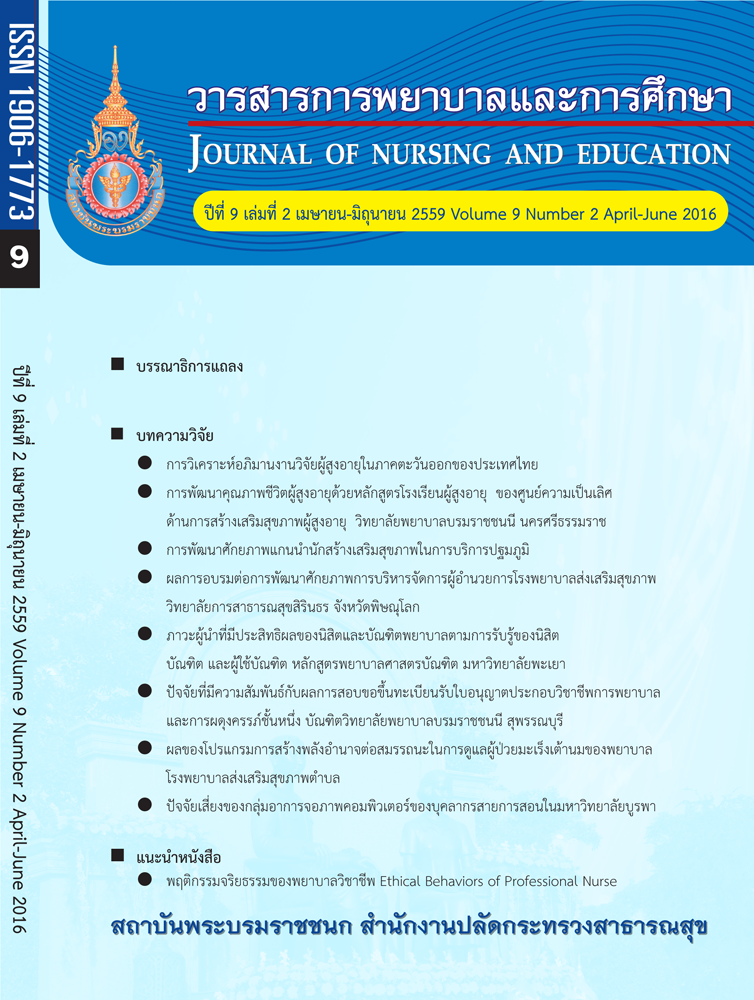ปัจจัยเสี่ยงของกลุ่มอาการจอภาพคอมพิวเตอร์ของบุคลากรสายการสอน ในมหาวิทยาลัยบูรพา
คำสำคัญ:
Computer vision Syndrome, Risk factors, Prevalence rateบทคัดย่อ
บทคัดย่อ
กลุ่มอาการจอภาพคอมพิวเตอร์ เป็นปัญหาสุขภาพที่มีความสัมพันธ์กับการทำงาน และมีแนวโน้มเพิ่มมากขึ้น เนื่องมาจากการขยายตัวอย่างรวดเร็วของการใช้เทคโนโลยีทางด้านคอมพิวเตอร์ในสถานที่ทำงาน แต่อย่างไรก็ตามยังมีผู้สนใจจำนวนน้อยที่สนใจศึกษาสภาพปัญหาดังกล่าว ดังนั้นการวิจัยครั้งนี้จึงมีจุดประสงค์เพื่อศึกษาอัตราชุก ความรุนแรง และปัจจัยเสี่ยงของกลุ่มอาการจอภาพคอมพิวเตอร์ ของบุคลากรสายการสอน ในมหาวิทยาลัยบูรพา กลุ่มตัวอย่าง ได้แก่ บุคลากรสายการสอนทั้งเพศชายและเพศหญิงที่ปฏิบัติงาน ในมหาวิทยาลัยบูรพา ณ จังหวัดชลบุรี จำนวน 210 คน เก็บรวบรวมข้อมูลโดยใช้แบบสอบถาม และ แบบบันทึกข้อมูล ข้อมูลด้วยโปรแกรมสำเร็จรูปสถิติทางสังคมศาสตร์ สถิติที่ใช้ ได้แก่ ความถี่ ร้อยละ และค่าความหนักแน่นของความสัมพันธ์ (OR) ที่ระดับความเชื่อมั่น 95%
ผลการวิจัย พบว่า อัตราชุกของกลุ่มอาการจอภาพคอมพิวเตอร์โดยภาพรวม ร้อยละ 79.5 ซึ่งประกอบด้วยอัตราชุกของอาการ Ocular Surface (76.2%) สูงสุด รองลงมา คือ อัตราชุกของอาการ Eye Strain และ Tired Eye (75.75%) อัตราชุกของอาการ Blurred Vision (60.5%) และอัตราชุกของอาการ Double Vision (40.5%) เมื่อวิเคราะห์ความสัมพันธ์ของปัจจัยเสี่ยง พบว่า ปัจจัยเสี่ยงด้านบุคคล (Host) ได้แก่ อายุ (OR = 2.39, 95 % CI = 1.04-5.48) ปัญหาทางสายตา (OR = 4.13, 95 % CI =1.95–8.76) และความเครียด (OR = 3.20, 95 % CI = 1.56-6.56) ปัจจัยเสี่ยงด้านสิ่งที่ทำให้เกิดโรค (Agent) ได้แก่ การกระพริบของตัวอักษร (OR = 2.34, 95 % CI = 1.17-4.67) ระยะเวลาที่ทำงานกับเครื่องคอมพิวเตอร์/ วัน (OR = 6.17, 95 % CI = 2.97– 12.76) และระยะห่างระหว่างตากับจอภาพ (OR = 4.06, 95 % CI =1.94-8.45) ปัจจัยเสี่ยงด้านสิ่งแวดล้อม (Environment) ได้แก่ สัดส่วนของแสง (OR = 2.73, 95 % CI = 1.34-5.54) และแสงสะท้อน (OR = 7.90, 95 % CI = 3.54-17.64)
ผลการศึกษานี้สามารถนำไปใช้ในการเฝ้าระวังความเสี่ยงด้านบุคคล สิ่งที่ทำให้เกิดโรค และด้านสิ่งแวดล้อม เพื่อการป้องกันและแก้ไขการเกิดกลุ่มอาการจอภาพคอมพิวเตอร์ รวมทั้งการส่งเสริมสุขภาพของพนักงานที่ใช้เครื่องคอมพิวเตอร์ทำงานเป็นหลัก ซึ่งจะนำไปสู่การลดอัตราชุกและความรุนแรงของการเกิดกลุ่มอาการจอภาพคอมพิวเตอร์
คำสำคัญ: กลุ่มอาการจอภาพคอมพิวเตอร์ ปัจจัยเสี่ยง อัตราชุก
Risk Factors of Computer Vision Syndromes Among Teaching Personal
in Burapha University
Abstract
Due to the rapidly expanding use of computers in the workplace, Computer Vision Syndrome (CVS) has increased. However, there is a few study in such an area. Thus, the purpose of this research was to examine the prevalence rate, severity level and risk factors of Computer Vision Syndrome among teaching personal in Burapha university. The sample consisted of 210 workers both males and females working with data on computers from selected teaching personal in Burapha university (Chonburi campus). Data gathering methods were self-administered questionnaires, record forms,. The data were analyzed by frequency, percentage, rate and Crude Odds Ratio (OR) by 95 % CI.
The results revealed that the overall prevalence rate of Computer Vision Syndrome was 79.5%, namely, 76.2 % for ocular surface prevalence; 75.7 % for eye strain and tired eye prevalence; 60.5 % for blurred vision prevalence ; and 40.5 % for double vision. The analysis of risk factors had showed that the host factors were age (OR = 2.39, 95 % Confident Interval = 1.04-5.48), vision problem (OR = 4.13, 95 % CI = 1.95–8.76), and stress (OR = 3.20, 95 % CI = 1.56-6.56). The agent factors were blink of the alphabet (OR = 2.34, 95 % CI = 1.17-4.67), work duration the daytime (OR =6.17, 95 % CI = 2.97– 12.76), distance between eyes and visual display terminal (OR = 4.06, 95 % CI = 1.94-8.45) and the environment factors were statistically significant associated with contrast (OR = 2.73, 95 % CI = 1.34-5.54) and glare on screen (OR = 7.90, 95 % CI = 3.54-17.64).
These findings suggest that employee who had inappropriate factors (host, agent and environment) would have more chance to risk of Computer Vision Syndrome than those who had appropriate factors. These provide basic information in order to monitor Computer Vision Syndrome in risk groups. These knowledge as a baseline in order to reduce prevalence rate and severity level of Computer Vision Syndrome.
Keywords: Computer vision Syndrome ; Risk factors ; Prevalence rate





